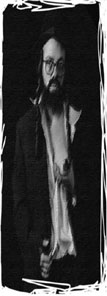
| HOME |
| NERVE |
| REVIEWS |
| ARCHIVE |
| EVENTS |
| LINKS |
| ABOUT US |
| CONTRIBUTORS |
| BACK ISSUES |
| CONTACT US |
 In
Conversation with Oreet Ashery
In
Conversation with Oreet Ashery
The Bluecoat
Reviewed by Minna Alanko
Offered an interesting insight into the life of this London-based Israeli artist whose main project of the past couple of years has been Marcus Fisher, an Orthodox Jewish man. Marcus Fisher is Oreet Ashery dressed in a traditional black outfit, sporting a full beard and a long curl of hair on each side of her head, sticking out from under a black hat. Video footage and photographs portray Marcus in bars, streets and parks of London, Berlin, New York and Tel-Aviv and document the reactions of people who encounter him. In the Liverpool Biennial of Contemporary Art 2002 Marcus Fisher vacated a room in the Holiday Inn hotel, and welcomed the public to come in, one by one, and join him for conversation and a photograph.
Marcus Fisher combines various moments of Oreet Ashery’s life. She recollects walking in the streets of her hometown Jerusalem with her father, and how her fascination for the Orthodox schools of the city was never fulfilled – as a girl she could not enter the men-only institutions. She was taught to dislike this extreme of Judaism and the regulations and restrictions it represented towards the more secular Jewish people like herself. As Marcus Fisher Ashery blurs the boundary between a female artist and a male representative of a religious culture that largely excludes women from its rituals. Importantly, she is also presenting this character as an individual and not simply a part of a group, taking him into an environment where the figure of an Orthodox is alien and an outsider.
Ashery has awoken controversy, interestingly not so much among Jewish communities but Western liberals. BBC 1 and 2 as well as Channel 4, who had all initially expressed interest in documenting the artist, withdrew their offers apparently due to the political and sexual issues of her art. One self-portrait in particular has caused a stir: that showing Oreet Ashery in full Marcus Fisher outfit, gazing down at her exposed right breast, gently cupped in her hands. Although the picture is meditative and non-violent, it is seen as threatening by the representatives of the media who seek to censor it. Yet especially commercialised media regularly conveys images which strengthen rather than question the prevailing consumerist and exploitative attitudes towards sexuality. It seems that it is not Ashery’s own heritage she is challenging but the Western society and its many stereotypes and preconceptions.